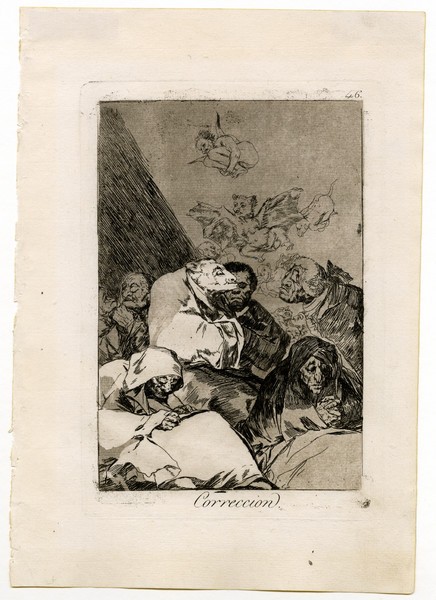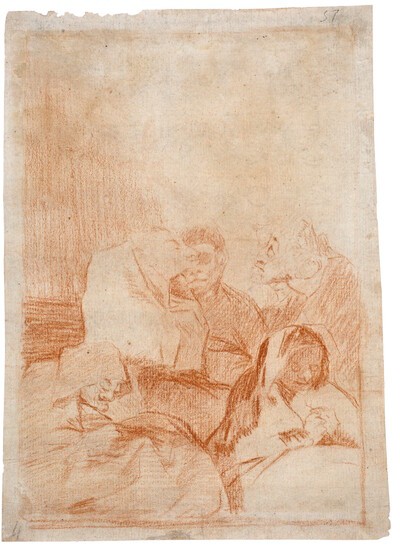- Cronología
- Ca. 1797 - 1799
- Dimensiones
- 217 x 150 mm
- Técnica y soporte
- Etching and burnished aquatint
- Reconocimiento de la autoría de Goya
- Undisputed work
- Ficha: realización/revisión
- 19 Dec 2010 / 29 May 2024
- Inventario
- 225
Correccion. (at the bottom)
46. (in the upper right-hand corner)
See Francisco de Goya y Lucientes, Painter.
A preparatory drawing for this engraving is in the Prado Museum.
The centre of the print is occupied by a figure seated in profile and covered with a tunic; his face is animal-like and his gesture is solemn. Behind him are three figures, all of them with stern expressions, and in front of him a man with a compassionate face, wearing a coat and a toupee. In the lower left corner, another man in a habit reads a devotional book on his knees, and next to him, another praying figure clasps his hands with interlaced fingers with a sorrowful air. Strange beings, hybrids between men and bats, fly in the sky in bizarre postures; they resemble the flying figure in Capricho no. 48, The Snitches.
Goya has made some reserves of varnish with which he has created the white parts such as those seen in the central figure and the one in the lower left-hand corner of the print. These lighter areas contrast sharply with the rest of the engraving, which remains in semi-darkness.
The manuscripts that explain The Caprices seem to agree that it is an act of witchcraft piloted by a character of no particular merit. In the manuscript in the Prado Museum there is a reference to the sorcerer who ran the seminary in Barahona. It is possible that one of the sources of inspiration for this engraving is the work by Leandro Fernández de Moratín (Madrid, 1760-Paris, 1828) entitled " Self-belief celebrated in the city of Logroño on 6 and 7 November 1610". It refers to the witches' covens that were practised in the countryside of Barahona, a small village in the south of Soria, which was long considered an important centre of witchcraft.
The aquatint of the plate is deteriorated ( National Chalcography, no. 217).
-
Goya. Gemälde Zeichnungen. Graphik. TapisserienKunsthalle BaselBasle1953from January 23th to April 12th 1953cat. 233
-
Goya. Das Zeitalter der Revolucionen. Kunst um 1800 (1980 – 1981)Hamburger KunsthalleHamburg1980cat. 5
-
Goya. La década de Los CaprichosMadrid1992organized by Real Academia de Bellas Artes de San Fernando sponsored by Fundación Central Hispano, Madrid, consultant editor Nigel Glendinnig. From October 26th 1992 to January 10th 1993cat. 111
-
Francisco de GoyaMuseo d'Arte ModernaLugano1996exhibition celebrated from September 22nd to November 17th.cat. 45, p.73
-
Francisco Goya. Sein leben im spiegel der graphik. Fuendetodos 1746-1828 Bordeaux. 1746-1996Galerie KornfeldBern1996from November 21st 1996 to January 1997cat. 52
-
Goya e la tradizione italianaFondazione Magnani RoccaMamiano di Traversetolo (Parma)2006consultant editors Fred Licht and Simona Tosini Pizzetti. From September 9th to December 3th 2006cat. 46, p.157
-
Goya. Opera graficaPinacoteca del Castello di San GiorgioLegnano2006exhibition celebrated from December 16th 2006 to April 1st 2007p.36
-
Goya e ItaliaMuseo de ZaragozaZaragoza2008organized by the Fundación Goya en Aragóna, consultant editor Joan Sureda Pons. From June 1st to September 15th 2008cat. 330
-
Goya et la modernitéPinacothèque de ParisParís2013from October 11st 2013 to March 16th 2014cat. 158
-
Goya engravings and lithographs, vol. I y II.OxfordBruno Cassirer1964p.119, cat. 81
-
Vie et ouvre de Francisco de GoyaParísOffice du livre1970p.181, cat. 543
-
Goya, la década de los caprichos: dibujos y aguafuertesMadridReal Academia de Bellas Artes de San Fernando1992pp.188-189, cat. 56
-
Catálogo de las estampas de Goya en la Biblioteca NacionalMadridMinisterio de Educación y Cultura, Biblioteca Nacional1996p.98, cat. 135
-
El libro de los caprichos: dos siglos de interpretaciones (1799-1999). Catálogo de los dibujos, pruebas de estado, láminas de cobre y estampas de la primera ediciónMadridMuseo Nacional del Prado1999pp.254-257
-
ParísPinacoteca de París2013p. 223
-
Goya. In the Norton Simon MuseumPasadenaNorton Simon Museum2016pp. 42-75

